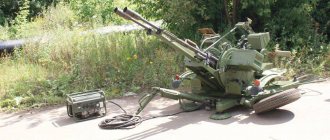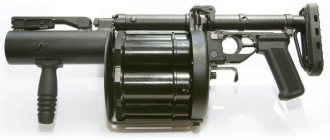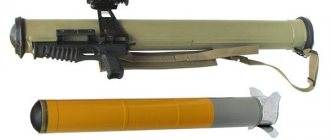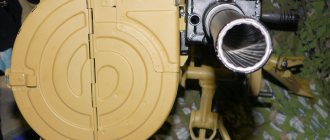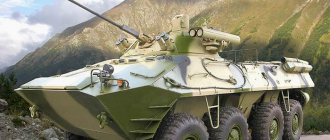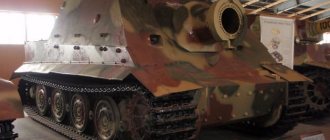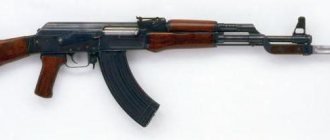Myth 3. The Kalashnikov assault rifle does not need to be cleaned
Another popular misconception. Allegedly, the AK is so reliable that you can quite easily drown it in the mud, and then take it out and lay down a burst of enemy infantry platoon running towards you in a frontal attack.
The famous quote Steel My Soldiers' Hearts by an American military journalist, uttered during the Vietnam War, is circulating on the Internet.
Standing nearby, I looked into the hole and pulled the AK out of the slurry. “Look, guys,” I said. “I’ll show you how real infantry weapons work.” I pulled back the bolt and fired 30 shots - the AK had not been cleaned since the day it fell into the swamp about a year ago. This was exactly the weapon that our soldiers needed, and not the M16 that had lost confidence.
David Hackworth
US Army Colonel.
Some even say that the AK is designed in such a way that it is capable of “self-cleaning” when firing. Press the trigger - and when firing, the machine will spit out not only bursts of lead, but also the dirt that has accumulated inside. All that remains is to wipe the handle on your pants and continue fighting.
Nevertheless, this is a misconception: These Are The Biggest Myths About the Infamous AK‑47 / National Interest, and a gross one at that. An AK is a reliable weapon, but even it cannot work without cleaning and lubrication. Corrosion, contamination of the barrel, problems with chambering and extraction of cartridges - all these troubles will immediately manifest themselves if you do not take care of the AK. This can result not only in damage to the machine, but also in serious injuries. Firing from a contaminated weapon is simply life-threatening.
The myth of the “self-cleaning” weapon originally appeared The Highly Successful M16 Rifle Suffered from a Terrible Reputation When It Was First Introduced in Vietnam / History Collection thanks to the American “analog” of the AK, the M16 rifle. When this gun was first brought to Vietnam, there were rumors among soldiers that it did not need to be cleaned.
And in theory, this is almost true, because the M16 has fewer design holes where dirt can get in. In addition, at first it was assumed that the rifle would be equipped with cartridges with a special gunpowder that would have virtually no carbon deposits.
But in practice it turned out that the Emka was even more sensitive to contamination than the AK, and the special cartridges for it were simply not produced in sufficient quantities. So any weapon requires cleaning, regardless of talk about “dirt resistance”.
Myth 4. Kalashnikov created the assault rifle alone
The most common version of the development of legendary weapons goes something like this. Tank sergeant Mikhail Kalashnikov was wounded in yet another battle with Wehrmacht troops and was sent to the rear for treatment. He just couldn’t stay in a military hospital, so he went and invented a machine gun that was superior to all the rifles in service with the Soviet Red Army.
But in fact, this story is fiction. Kalashnikov, of course, is an outstanding designer, but the AK can hardly be called his sole invention.
The first prototypes of the machine gun were generally rejected by the selection committee, and it took many years of improvements carried out through the efforts of a whole group of Soviet engineers.
By the way, Mikhail Kalashnikov never hid this and described it in detail by M. T. Kalashnikov. Notes of a gunsmith designer are the work of all the gunsmiths who finalized his brainchild, in particular the designers Zaitsev and Dementyev.
Which cartridge is more effective? 7.62x39 versus 5.56x45
Magazines loaded with 5.56x45 mm cartridges
Even if you're not into firearms, you can probably still list a few common calibers. And if we narrow it down to long-barreled weapons, then probably two. The most widely used cartridges in the world are two cartridges for automatic weapons: 5.56x45 mm and 7.62x39 mm. The first of them is the standard NATO cartridge for assault rifles, the second is inextricably linked with the famous AK-47 and its numerous clones and is even more widespread.
Armies around the world, as well as police forces, rely on these two cartridges for their excellent, time-tested performance. Ammunition has earned its place in the sun thanks to its good firing range, accuracy, and lethality. Moreover, each of these two cartridges has its own characteristics. In some ways one is better, in others the other. Disputes about which cartridge is more successful continue today, and heated discussions can often be observed on the Internet. At the same time, we should not forget that in such a dispute it is very difficult to find the truth. In real combat, much depends not so much on the cartridge itself, but on the shooter, his level of training and weapon proficiency, as well as on the weapon itself.
At the same time, armies do not abandon both calibers, since the systems adopted for service are focused on solving different combat missions. While machine guns/assault rifles today are almost always available in 5.56 (NATO) or 5.45 (Soviet/Russian systems), sniper weapons and machine guns are still available in 7.62x51 (NATO) or 7.62x54 ( Russia). But now we will talk first of all about intermediate cartridges and their advantages and disadvantages.
When did the most common intermediate cartridges appear?
The most common intermediate cartridges in the world are 5.56x45 mm and 7.62x39 mm. The old man here is the Soviet intermediate cartridge 7.62x39 mm model 1943. This ammunition was developed during the Second World War, but was not used in combat conditions. The creation in the USSR of a 7.62-mm intermediate cartridge and its adoption into service opened up new prospects in the design of various types of automatic weapons. The famous Kalashnikov assault rifle, also known as AK-47, adopted for service in 1949, was created specifically for this cartridge. Together with the AK, the 7.62x39 cartridge became widespread throughout the world in the post-war years. So widely that in the 1960s the possibility of adopting it as an additional automatic cartridge in NATO countries was even seriously discussed.
Soviet cartridges: 7.62x54 mm (rifle), 7.62x39 mm (intermediate) and 7.62x25 mm (pistol)
However, it never came to that. Largely due to the appearance of an intermediate low-pulse cartridge 5.56x45 mm. This cartridge was developed in the USA in 1959 and went into production in 1961. The cartridge was created on the basis of the existing .223 Remington hunting ammunition. As with the Kalashnikov assault rifle, the proliferation of ammunition was facilitated by the creation of effective small arms. It was for this cartridge that Eugene Stoner developed almost all of his models of small arms, including the famous M16 assault rifle. In the 1970s, the cartridge began to be widely used in NATO countries and by the mid-1980s it became standard for all NATO countries.
The development of intermediate cartridges in the USSR and the USA was preceded by the same conclusions. Existing rifle cartridges were excessively powerful for modern automatic weapons. At the same time, the standard NATO cartridge 7.62x51 mm was also recognized as being too heavy, which directly affected the ammunition carried by the soldier. In the changed conditions of warfare, this was no longer acceptable. In addition, intermediate cartridges ensured a reduction in the weight of the weapon itself and reduced recoil when firing, which ensured a greater effective firing range in bursts.
Obviously, the 7.62 mm cartridge weighed more than the 5.56 mm. At first glance, the difference is not that big: 16 grams versus 12 grams. However, in an ammunition load of 100 rounds this already gave a difference of 400 grams. And if we consider the shooter’s standard ammunition load of 8 magazines, the difference became even more noticeable, since the weight of the ammunition carried increased by a kilogram. For long forced marches this is already very significant. That is why, by 1974, the USSR also created an intermediate low-pulse cartridge of 5.45x39 mm caliber, characterized by an even lower weight - 10 grams.
What are the pros and cons of 7.62x39 and 5.56x45 cartridges?
Both intermediate cartridges are widely used in the armies of various countries around the world to this day. However, it is very difficult to determine which one is better for the average shooter (largely due to the bias of such assessments: in some cases it will be a question solely of the shooter's preferences). To avoid this, people usually try to rate ammunition in three main categories: power, recoil, and accuracy. It is easier to compare with these categories, since all three parameters can be easily assessed both theoretically and in practice.
Cartridges: 7.62x39 mm (left) and 5.56x45 mm (right)
The 5.56x45 mm low-impulse intermediate cartridge, created later, has a number of undeniable advantages. Its bullet is almost two times lighter than the bullet of the 7.62x39 mm cartridge. Therefore, even despite the increased flight speed, the recoil impulse was reduced. This had a positive effect on the accuracy of shooting from automatic weapons. The machine simply shook less when firing in bursts. It became more comfortable for the shooter to fire, dispersion decreased, and, therefore, the probability of hitting the target increased.
Among other things, due to the higher speed of the bullet, the flatness of the trajectory has improved. A shooter using 5.56mm ammunition will find it easier to aim as there are fewer adjustments to make for wind or altitude. This is especially important for long-range shooting. The average flight speed of a 7.62x39 mm cartridge bullet is 720 m/s; for a 5.56x45 mm cartridge bullet this is already 1006 m/s. At a distance of 100 meters there is still no difference in the reduction in the trajectory of the bullet for the two cartridges, but already at a distance of 250 meters the 7.62 mm bullet is reduced by 40 cm. The trajectory of the bullet of the 5.56 mm cartridge is flatter and provides a greater range of effective straight shot. At a distance of up to 250 meters it practically does not decrease.
Despite all of the above, the most common automatic cartridge on the planet is still the Soviet 7.62x39 mm, which has spread around the world thanks to the AK-47 assault rifle and its numerous copies, both licensed and not. This ammunition also has its advantages. The first and most obvious is bullet weight. Ammunition of this caliber is more preferable if you are firing at a target wearing body armor. A heavy bullet retains energy much better over long distances, having better striking and stopping effect.
The advantages of 7.62x39 mm cartridges are also a lower likelihood of ricochet and much more stable overcoming of obstacles. The bullet confidently overcomes thickets, leaves, and branches, while a 5.56 mm bullet can seriously change its trajectory if it encounters even a minor obstacle. What can we say, boards and bricks for 7.62 mm ammunition are often also a completely surmountable obstacle. Moreover, when it hits a bone, such a bullet provides a more severe wound. But low-impulse cartridges of intermediate caliber provide more severe wounds, hitting soft tissue.
The most common weapon on the planet: AK-47 with 7.62x39 mm cartridges
The obvious disadvantages of the 7.62x39 mm cartridge include higher recoil when firing. High recoil makes it difficult for the shooter to get an accurate second and third shot, depending on the weapon he is using, as well as the ability to fire bursts effectively and accurately. In turn, due to a flatter trajectory, low-impulse intermediate cartridges are considered simpler for mass armies with a conscription system, when a large number of new soldiers must be constantly trained in shooting. This is not the last reason why the 5.45 mm cartridge still remains the most popular in Russia, although the military is discussing options for returning to the 7.62 mm caliber or creating new ammunition.
If we summarize the results when comparing according to three main criteria, then everything is quite simple. The intermediate cartridge 7.62x39 mm wins in power, but loses to the 5.56x45 mm cartridge in accuracy and recoil. For the average shooter, when firing at long distances, the intermediate low-pulse cartridge 5.56x45 mm, as well as its Russian counterpart 5.45x39 mm, seem more preferable.
Myth 5. AK is a copy of the German StG 44 assault rifle by Hugo Schmeisser
Schmeisser StG‑44 assault rifle.
Image: Wikimedia Commons In general, these machines are similar in appearance. Therefore, many lovers of foreign weapons, noticing the similarities, begin to say something like: “The Russians cannot come up with anything of their own and they steal everything from the Germans.”
However, the rifles are structurally different.
Strictly speaking, in the USSR the first such weapon was created by S. B. Monetchikov. The history of the Russian assault rifle in 1943 by engineer Alexey Sudaev. By itself, his machine was not perfect enough to put production on stream. But many of the ideas gained during its development were applied to the AK-47.
AK with StG 44 has a couple of similar features A. A. Malimon. Domestic machine guns (notes of a gunsmith tester). For example, in both cases, the automation operates due to a gas outlet, and both carbines - at least in their early versions - have a breakable receiver to facilitate disassembly.
But at the same time, a similar system for removing powder gases was used in the Simonov ABC-36 rifle long before Schmeisser’s invention. So there is a mystery here, who copied what from whom.
Myth 1. AK is very heavy
Image: denisk999 / Depositphotos This misconception came to us M16 rifle / Britannica from America.
There it is traditionally believed that the Russian Kalashnikov is reliable, but at the same time extremely heavy. And an untrained shooter will use it to empty the entire clip into the white light like it’s a pretty penny - that’s how this monster twitches in his hands. And the M16 is supposedly more capricious and requires more delicate handling, but it is much lighter and more convenient. And it allows you to shoot more accurately. But this was true in the 50s, when an AK with an empty magazine weighed N.I. Naidin. Shooting manual. The 7.62 mm modernized Kalashnikov assault rifle weighs 4.3 kg, and the M16 is 1 kg less. But a modern Kalashnikov weighs 3.93 kg versus 4 kg for its foreign analogue RB Stevens. The Black Rifle M16 Retrospective. So there's parity here. The AK-47 is neither heavier nor lighter.
Myth 2. A shot from an AK penetrates a railway rail
This is one of the most popular myths that even those who do not understand weapons have heard. The AK is endowed with some incredible armor-piercing power: it will shoot through a rail, a tree, and an enemy hiding behind it. And it will supposedly even penetrate tank armor.
In reality, if you try to shoot through a rail with standard hunting or military ammunition, nothing will work - have gun enthusiasts long ago tested whether an AK penetrates a rail? Myth and reality / WarGonzo. Most likely, the shooter will get a ricochet - if he’s lucky, it won’t hit any vital organs.
Only armor-piercing charges of the 7N23 type have a chance, and only if you shoot at a non-hot (and preferably rusty) rail.
The military Kalashnikov assault rifle cartridge, marked M43, has excellent armor penetration performance for its class. However, only a maniac with an incredible desire for destruction, but without the instinct of self-preservation, would shoot from it at thick steel things.

